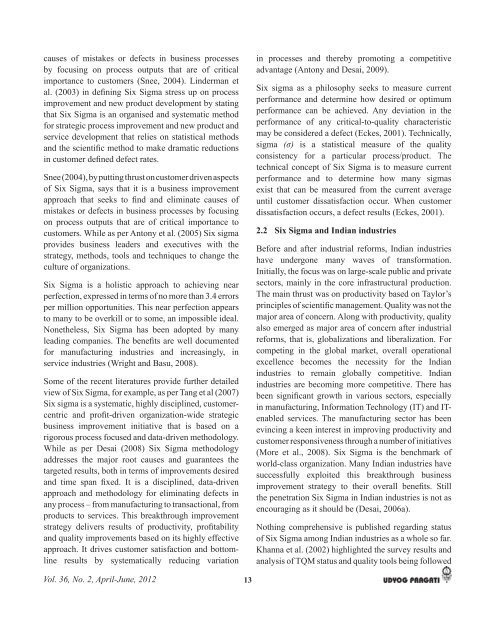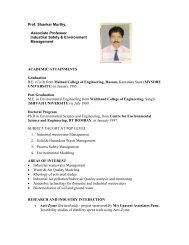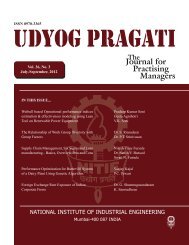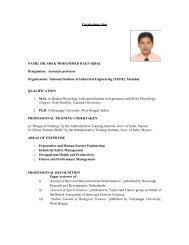Apr-Jun.12 - the Nitie
Apr-Jun.12 - the Nitie
Apr-Jun.12 - the Nitie
You also want an ePaper? Increase the reach of your titles
YUMPU automatically turns print PDFs into web optimized ePapers that Google loves.
causes of mistakes or defects in business processes<br />
by focusing on process outputs that are of critical<br />
importance to customers (Snee, 2004). Linderman et<br />
<br />
improvement and new product development by stating<br />
that Six Sigma is an organised and systematic method<br />
for strategic process improvement and new product and<br />
service development that relies on statistical methods<br />
<br />
<br />
Snee (2004), by putting thrust on customer driven aspects<br />
of Six Sigma, says that it is a business improvement<br />
<br />
mistakes or defects in business processes by focusing<br />
on process outputs that are of critical importance to<br />
customers. While as per Antony et al. (2005) Six sigma<br />
provides business leaders and executives with <strong>the</strong><br />
strategy, methods, tools and techniques to change <strong>the</strong><br />
culture of organizations.<br />
Six Sigma is a holistic approach to achieving near<br />
perfection, expressed in terms of no more than 3.4 errors<br />
per million opportunities. This near perfection appears<br />
to many to be overkill or to some, an impossible ideal.<br />
None<strong>the</strong>less, Six Sigma has been adopted by many<br />
<br />
for manufacturing industries and increasingly, in<br />
service industries (Wright and Basu, 2008).<br />
Some of <strong>the</strong> recent literatures provide fur<strong>the</strong>r detailed<br />
view of Six Sigma, for example, as per Tang et al (2007)<br />
Six sigma is a systematic, highly disciplined, customer-<br />
<br />
business improvement initiative that is based on a<br />
rigorous process focused and data-driven methodology.<br />
While as per Desai (2008) Six Sigma methodology<br />
addresses <strong>the</strong> major root causes and guarantees <strong>the</strong><br />
targeted results, both in terms of improvements desired<br />
<br />
approach and methodology for eliminating defects in<br />
any process – from manufacturing to transactional, from<br />
products to services. This breakthrough improvement<br />
<br />
and quality improvements based on its highly effective<br />
approach. It drives customer satisfaction and bottomline<br />
results by systematically reducing variation<br />
in processes and <strong>the</strong>reby promoting a competitive<br />
advantage (Antony and Desai, 2009).<br />
Six sigma as a philosophy seeks to measure current<br />
performance and determine how desired or optimum<br />
performance can be achieved. Any deviation in <strong>the</strong><br />
performance of any critical-to-quality characteristic<br />
may be considered a defect (Eckes, 2001). Technically,<br />
sigma is a statistical measure of <strong>the</strong> quality<br />
consistency for a particular process/product. The<br />
technical concept of Six Sigma is to measure current<br />
performance and to determine how many sigmas<br />
exist that can be measured from <strong>the</strong> current average<br />
until customer dissatisfaction occur. When customer<br />
dissatisfaction occurs, a defect results (Eckes, 2001).<br />
2.2 Six Sigma and Indian industries<br />
Before and after industrial reforms, Indian industries<br />
have undergone many waves of transformation.<br />
Initially, <strong>the</strong> focus was on large-scale public and private<br />
sectors, mainly in <strong>the</strong> core infrastructural production.<br />
The main thrust was on productivity based on Taylor’s<br />
<br />
major area of concern. Along with productivity, quality<br />
also emerged as major area of concern after industrial<br />
reforms, that is, globalizations and liberalization. For<br />
competing in <strong>the</strong> global market, overall operational<br />
excellence becomes <strong>the</strong> necessity for <strong>the</strong> Indian<br />
industries to remain globally competitive. Indian<br />
industries are becoming more competitive. There has<br />
<br />
in manufacturing, Information Technology (IT) and ITenabled<br />
services. The manufacturing sector has been<br />
evincing a keen interest in improving productivity and<br />
customer responsiveness through a number of initiatives<br />
(More et al., 2008). Six Sigma is <strong>the</strong> benchmark of<br />
world-class organization. Many Indian industries have<br />
successfully exploited this breakthrough business<br />
<br />
<strong>the</strong> penetration Six Sigma in Indian industries is not as<br />
encouraging as it should be (Desai, 2006a).<br />
Nothing comprehensive is published regarding status<br />
of Six Sigma among Indian industries as a whole so far.<br />
Khanna et al. (2002) highlighted <strong>the</strong> survey results and<br />
analysis of TQM status and quality tools being followed<br />
Vol. 36, No. 2, <strong>Apr</strong>il-June, 2012<br />
13

















